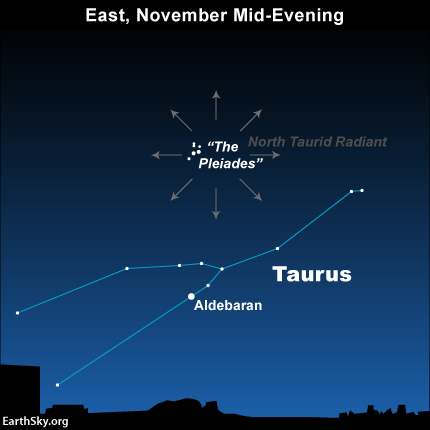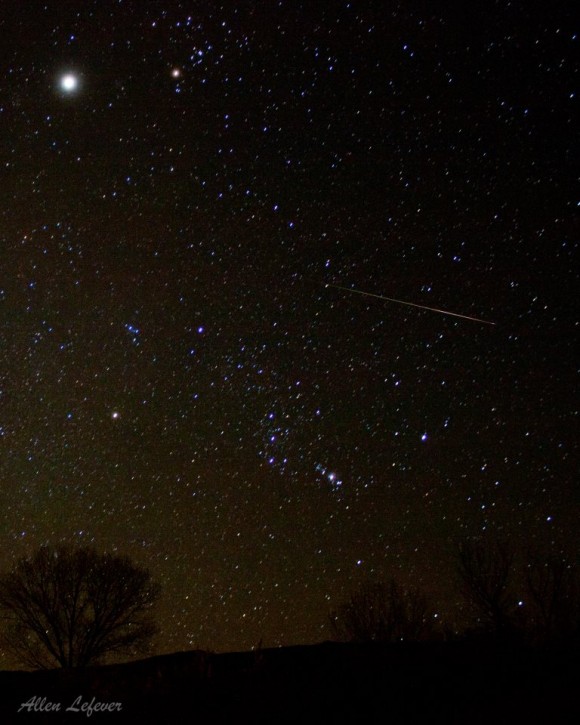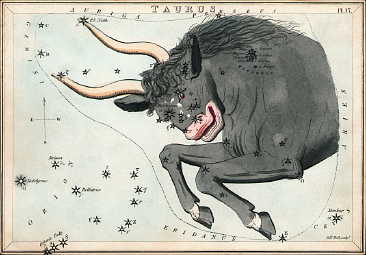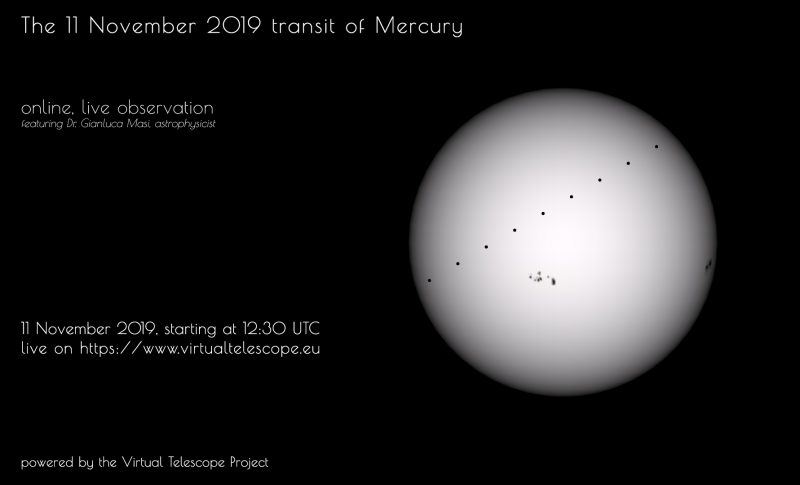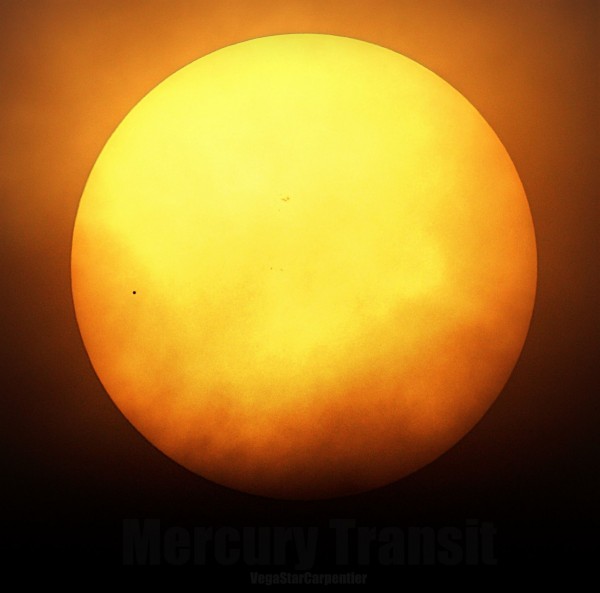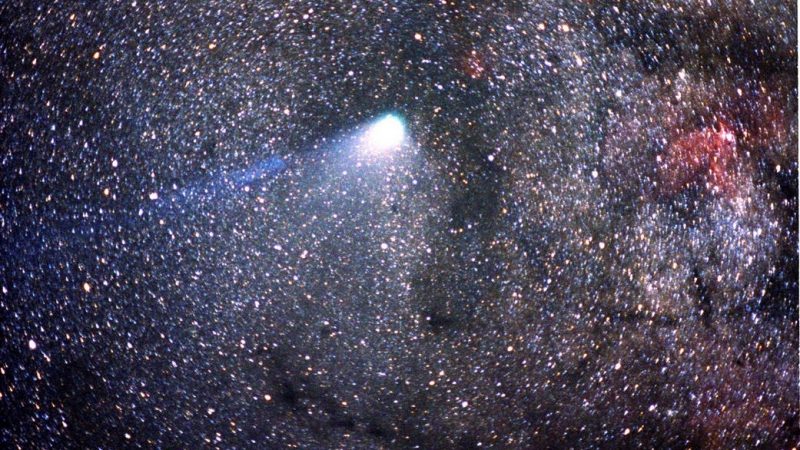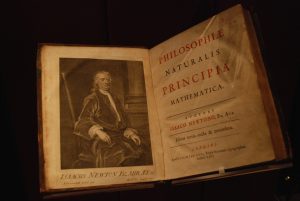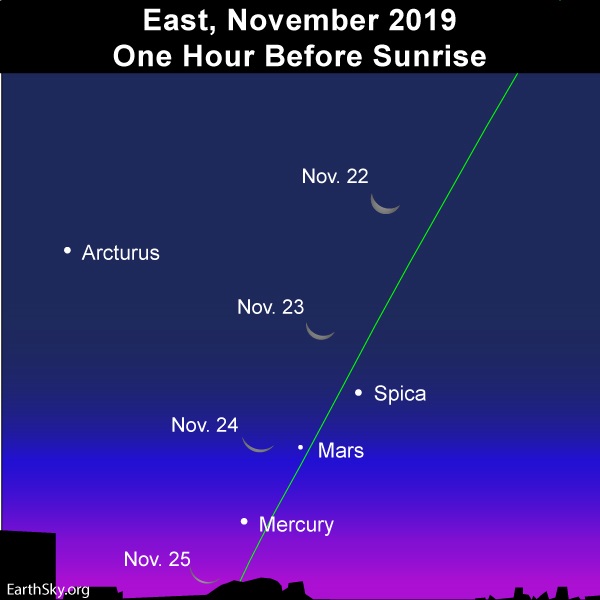
Photo at top: Mercury transit, May 9, 2016 via @altair_astro on Twitter. See more photos of the 2016 Mercury transit.
Mercury – the innermost planet of our solar system – will transit the sun on November 11, 2019. In other words, Mercury will pass directly in front of the sun and be visible through telescopes with solar filters as a small black dot crossing the sun’s face. It’ll be visible in part from most of Earth’s globe. The entire transit is visible from South America, eastern North America, and far-western Africa.
The last transit of Mercury was in 2016. The next one won’t be until 2032.
Mercury will come into view on the sun’s face around 7:36 a.m. Eastern Standard Time (12:36 UTC; translate UTC to your time) on November 11. It’ll make a leisurely journey across the sun’s face, reaching greatest transit (closest to sun’s center) at approximately 10:20 a.m. EST (15:20 UTC) and finally exiting around 1:04 p.m. EST (18:04 UTC). The entire 5 1/2 hour path across the sun will be visible across the U.S. East – with magnification and proper solar filters – while those in the U.S. West can observe the transit already in progress after sunrise.
Translate UTC to your time
EarthSky 2020 lunar calendars are available! They make great gifts. Order now. Going fast!
You need a telescope and solar filters to view the transit. Mercury’s diameter is only 1/194th of that of the sun, as seen from Earth. That’s why the eclipse master Fred Espenak recommends using a telescope with a magnification of 50 to 100 times for witnessing the event.
Unless you are well-versed with the telescope and how to properly use solar filters, we advise you to seek out a public program via a nearby observatory or astronomy club. Never look at the sun through a telescope.
Click here to find a public presentation of the Mercury transit near you.
Or try an online view of the transit. The Virtual Telescope Project is hosting one.
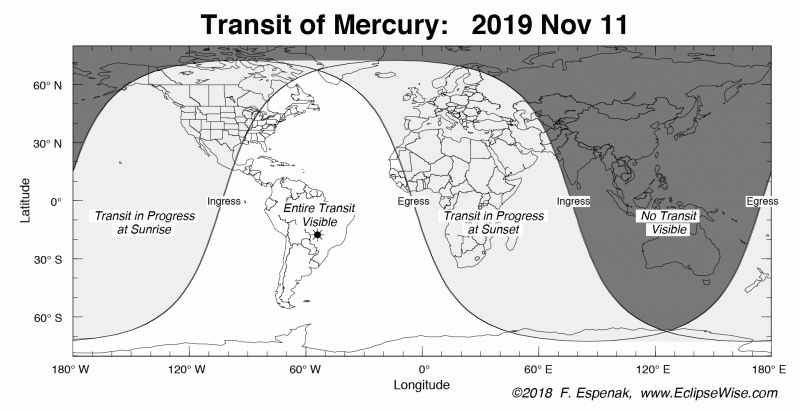
View larger. | The entire November 11, 2019, transit is visible from South America, eastern North America, and far-western Africa. Image via Eclipsewise.
What part of Earth will see the November 11 transit of Mercury? As shown on the worldwide chart above, the transit will be visible (at least in part) from most of the globe, with the exception of the shaded-out portion (Indonesia, most of Asia, and Australia). Mercury takes some 5 1/2 hours to cross the sun’s disk, and this transit of Mercury is entirely visible (given clear skies) from eastern North America, South America, the southern tip of Greenland, and far-western Africa.
For North America, the transit begins in the early morning hours on November 11. The eastern part of North America sees the start of the transit after sunrise November 11, whereas the western part sees the transit already in progress as the sun rises on November 11.
As for the world’s Eastern Hemisphere – Africa, Europe, the Middle East and New Zealand – the transit starts in the early afternoon November 11 in the westernmost parts of Africa and Europe, and in the late afternoon November 11 in eastern Europe and the Middle East. In New Zealand, the transit begins in the late afternoon on November 12.
We provide the geocentric (Earth-centered) contact times of the transit of Mercury in Universal Time (UTC). If you know how to convert Universal Time to your local time (here’s how to do it), you can get a good approximation of the contact times for the Mercury transit for your part of the world. NOTE: Because the transit is viewed from the Earth’s surface, instead of the Earth’s center, the contact times could differ from the geocentric contact times by up to a minute.
Read more: How to safely observe the Mercury transit
Transit of Mercury on 11 November 2019, from Society for Popular Astronomy on Vimeo.
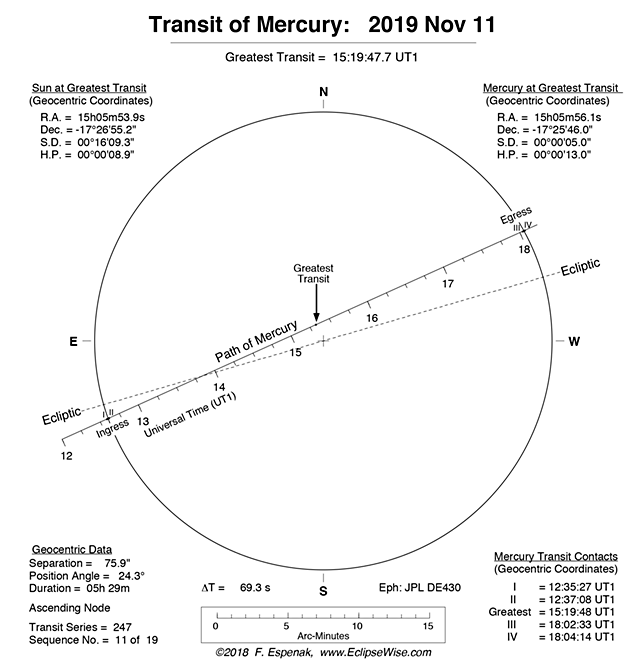
View larger. | The transit times in Universal Time as viewed from the center of the Earth. Visit timeanddate.com to find out the local transit times from your part of the world. Image via EclipseWise.
November 11 transit times in Universal Time
First contact (ingress, exterior): 12:35:27 UT
Second contact (ingress, interior): 12:37:08 UT
Greatest transit: 15:19:48 UT
Third contact (egress, interior): 18:02:33 UT
Fourth contact (egress, exterior): 18:04:14 UT
Want to know if and when the transit happens in your sky? Click here to find out your local transit times via timeanddate.com.
Mercury transit times for select North American cities in your local time
The times below are in your local time (meaning no conversion is necessary). We give transit contact times for various North American cities and Honolulu, Hawaii.
NOTE: All places within the same time zone have very similar contact times.
Newfoundland Daylight Time (NST)
St. Johns, Newfoundland:
First contact (ingress, exterior): 9:05:56 a.m. NST
Second contact (ingress, interior): 9:07:38 a.m. NST
Greatest transit: 11:50:03 a.m. NST
Third contact (egress, interior): 2:32:33 p.m. NST
Fourth contact (egress, exterior): 2:34:14 p.m. NST
Atlantic Standard Time (AST)
Halifax, Nova Scotia:
First contact (ingress, exterior): 8:36:00 a.m. AST
Second contact (ingress, interior): 8:37:42 a.m. AST
Greatest transit: 11:20:08 a.m. AST
Third contact (egress, interior): 2:02:36 p.m. AST
Fourth contact (egress, exterior): 2:04:17 p.m. AST
Eastern Standard Time (EST)
New York City, New York:
First contact (ingress, exterior): 7:36:04 a.m. EST
Second contact (ingress, interior): 7:37:48 a.m. EST
Greatest transit: 10:20:13 a.m. EST
Third contact (egress, interior): 1:02:39 p.m. EST
Fourth contact (egress, exterior): 1:04:20 p.m. EST
Central Standard Time (CST)
New Orleans, Lousiana:
First contact (ingress, exterior): 6:36:08 a.m. CST
Second contact (ingress, interior): 6:37:49 a.m. CST
Greatest transit: 9:20:20 a.m. CST
Third contact (egress, interior): 12:02:45 p.m. CST
Fourth contact (egress, exterior): 12:04:26 p.m. CST
Mountain Standard Time (MST)
Denver, Colorado:
First contact (ingress, exterior): sun below horizon
Second contact (ingress, interior): sun below horizon
Greatest transit: 8:20:24 a.m. MST
Third contact (egress, interior): 11:02:54 a.m. MST
Fourth contact (egress, exterior): 11:04:35 a.m. MST
Pacific Standard Time (PST)
Los Angeles, California:
First contact (ingress, exterior): sun below horizon
Second contact (ingress, interior): sun below horizon
Greatest transit: 7:20:08 a.m. PST
Third contact (egress, interior): 10:03:00 a.m. PST
Fourth contact (egress, exterior): 10:04:41 a.m. PST
Alaska Standard Time (AKST)
Juneau, Alaska:
First contact (ingress, exterior): sun below horizon
Second contact (ingress, interior): sun below horizon
Greatest transit: 7:40:25 a.m. AKST
Third contact (egress, interior): 9:03:04 a.m. AKST
Fourth contact (egress, exterior): 9:04:45 a.m. AKST
Hawaii-Aleutian Standard Time HST)
Honolulu, Hawaii:
First contact (ingress, exterior): sun below horizon
Second contact (ingress, interior): sun below horizon
Greatest transit: sun below horizon
Third contact (egress, interior): 8:03:13 a.m. HST
Fourth contact (egress, exterior): 8:04:54 a.m. HST
Transit contact times for many more North American cities via Fred Espenak’s EclipseWise.com:
United States Cities
Canadian Cities
Need more? More world transit times from timeanddate.com
How common are transits of Mercury? Although much more common than transits of Venus, a transit of Mercury happens only 14 times in the 21st century (2001 to 2100).
Transits of Mercury always occur in either May or November.
The last four were in 1999 (November 15), 2003 (May 7), 2006 (November 8) and 2016 (May 9); the next will be on November 11, 2019, and the next after that will be November 13, 2032.

A planet that orbits the sun inside Earth’s orbit is called an inferior planet. When an inferior planet passes between the Earth and sun at inferior conjunction, it can pass north of the sun, south of the sun – or, in rare cases, right in front of the sun.
What causes a transit of Mercury? Only planets that orbit the sun inside of Earth’s orbit – Mercury and Venus – ever transit the sun, as seen from Earth. If Mercury orbited the sun on the same plane that Earth does, there would be three to four transits of Mercury each calendar year.
However, Mercury’s orbital plane in inclined at 7 degrees to the ecliptic (Earth’s orbital plane). That means when Mercury swings between the Earth and sun at inferior conjunction (see illustration below) every four or so months, Mercury usually sweeps to the north or south of the solar disk. Therefore a transit of Mercury is fairly rare, only happening 13 to 14 times per century.
Each time Mercury circles the sun in its short and swift orbit of 88 Earth-days, Mercury travels north of the ecliptic (Earth’s orbital plane) for about half its orbit, and south of the ecliptic during the other half of its orbit. Twice in its orbit, Mercury crosses the Earth’s orbital plane at points called nodes. When Mercury is traveling from north to south, it’s called a descending node; and when Mercury is traveling south to north, it’s called an ascending node.
Whenever Mercury crosses a node in close vicinity to reaching inferior conjunction, a transit of Mercury is not only possible but inevitable. Mercury crosses its ascending node almost concurrently with Mercury at inferior conjunction on November 11, 2019, to present a rather rare transit of Mercury.
Descending node transits can only happen during the first half of May, and ascending node transits in the first half of November. At other times of the year, Mercury at inferior conjunction would either pass north or south of the sun’s disk.
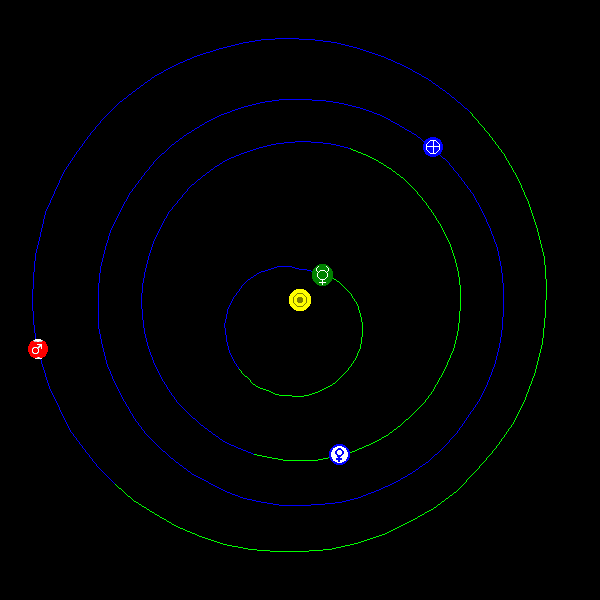
Bird’s-eye view of the inner solar system (Mercury, Venus, Earth and Mars) as seen from the north side of the ecliptic (Earth’s orbital plane) on November 11, 2019. From this vantage point, all the planets orbit the sun counterclockwise. The blue parts of the planetary orbits are north of the ecliptic plane whereas the green parts are south of the ecliptic. On November 11, 2019, Mercury crosses its ascending node, going from south to north, at nearly the same time that it passes between the Earth and sun at inferior conjunction Image via Solar System Live.
Dates for transits of Mercury in the 21st century (2001 to 2100). All Mercury transits happen in either May (descending node) or November (ascending node).
May 7, 2003
Nov 8, 2006
May 9, 2016
Nov 11, 2019
Nov 13, 2032
Nov 7, 2039
May 7, 2049
Nov 9, 2052
May 10, 2062
Nov 11, 2065
Nov 14, 2078
Nov 7, 2085
May 8, 2095
Nov 10, 2098
November (ascending node) transits happen about twice as often as May (descending node) transits. This is because Mercury has a very eccentric (oblong) orbit whereby Mercury comes a whopping 24 million kilometers (15 million miles) closer to the sun at perihelion (closest point to the sun in its orbit) than at aphelion (farthest point). In May, Mercury is rather close to aphelion, and quite far from the sun, which severely narrows the window of opportunity for a May transit. In November, Mercury swings rather near perihelion, and quite close to the sun, widening the period of time during which a November transit is possible.
Mercury transit cycles. Note that after a May transit, a November transit faithfully comes 3.5 years later (for instance: May 9, 2016 and November 11, 2019). Transits recur on nearly the same date in cycles of 46 years (for instance: May 9, 2016 and May 10, 2062). November transits, which are more common than May transits, occasionally recur in periods of 7 years, and more frequently in periods of 13 and 33 years.
May transits, which are less common than November transits, frequently recur in periods of 13 and/or 33 years. The 46-year cycle represents a combination of 13 and 33 years (13 + 33 = 46).
Seven century catalog of Mercury transits: 1601 A.D. to 2300 A.D.
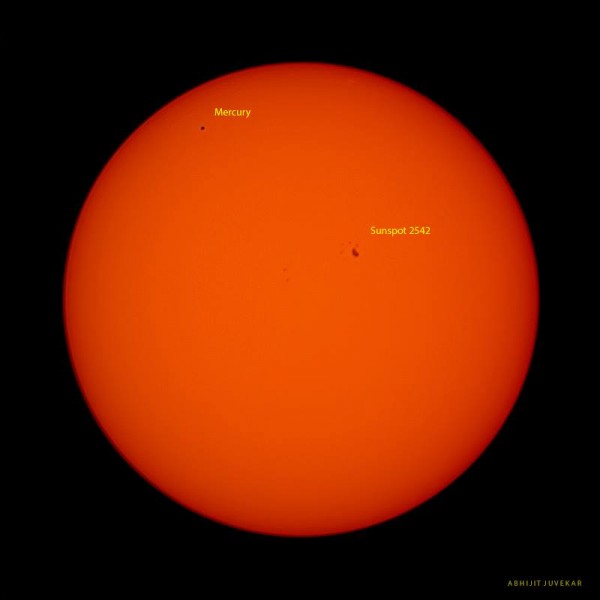
May 9, 2016, Mercury transit as captured by Abhijit Juvekar in India. He wrote: “Although it is rare event to be seen from Earth, such transit events can be seen commonly any time if you have spaceship capable of going at exact place where you can see planet aligned with sun. Maybe in the future, people will see transit events like these while their routine trips from one planet to another just the same as we take train to commute from home to office today.” See more photos of the 2016 Mercury transit.
Bottom line: Our solar system’s innermost planet, Mercury, passes directly in front of the sun on November 11, 2019. Who will see it, how to watch, equipment needed, transit times.
from EarthSky https://ift.tt/2qD8nbD

Photo at top: Mercury transit, May 9, 2016 via @altair_astro on Twitter. See more photos of the 2016 Mercury transit.
Mercury – the innermost planet of our solar system – will transit the sun on November 11, 2019. In other words, Mercury will pass directly in front of the sun and be visible through telescopes with solar filters as a small black dot crossing the sun’s face. It’ll be visible in part from most of Earth’s globe. The entire transit is visible from South America, eastern North America, and far-western Africa.
The last transit of Mercury was in 2016. The next one won’t be until 2032.
Mercury will come into view on the sun’s face around 7:36 a.m. Eastern Standard Time (12:36 UTC; translate UTC to your time) on November 11. It’ll make a leisurely journey across the sun’s face, reaching greatest transit (closest to sun’s center) at approximately 10:20 a.m. EST (15:20 UTC) and finally exiting around 1:04 p.m. EST (18:04 UTC). The entire 5 1/2 hour path across the sun will be visible across the U.S. East – with magnification and proper solar filters – while those in the U.S. West can observe the transit already in progress after sunrise.
Translate UTC to your time
EarthSky 2020 lunar calendars are available! They make great gifts. Order now. Going fast!
You need a telescope and solar filters to view the transit. Mercury’s diameter is only 1/194th of that of the sun, as seen from Earth. That’s why the eclipse master Fred Espenak recommends using a telescope with a magnification of 50 to 100 times for witnessing the event.
Unless you are well-versed with the telescope and how to properly use solar filters, we advise you to seek out a public program via a nearby observatory or astronomy club. Never look at the sun through a telescope.
Click here to find a public presentation of the Mercury transit near you.
Or try an online view of the transit. The Virtual Telescope Project is hosting one.

View larger. | The entire November 11, 2019, transit is visible from South America, eastern North America, and far-western Africa. Image via Eclipsewise.
What part of Earth will see the November 11 transit of Mercury? As shown on the worldwide chart above, the transit will be visible (at least in part) from most of the globe, with the exception of the shaded-out portion (Indonesia, most of Asia, and Australia). Mercury takes some 5 1/2 hours to cross the sun’s disk, and this transit of Mercury is entirely visible (given clear skies) from eastern North America, South America, the southern tip of Greenland, and far-western Africa.
For North America, the transit begins in the early morning hours on November 11. The eastern part of North America sees the start of the transit after sunrise November 11, whereas the western part sees the transit already in progress as the sun rises on November 11.
As for the world’s Eastern Hemisphere – Africa, Europe, the Middle East and New Zealand – the transit starts in the early afternoon November 11 in the westernmost parts of Africa and Europe, and in the late afternoon November 11 in eastern Europe and the Middle East. In New Zealand, the transit begins in the late afternoon on November 12.
We provide the geocentric (Earth-centered) contact times of the transit of Mercury in Universal Time (UTC). If you know how to convert Universal Time to your local time (here’s how to do it), you can get a good approximation of the contact times for the Mercury transit for your part of the world. NOTE: Because the transit is viewed from the Earth’s surface, instead of the Earth’s center, the contact times could differ from the geocentric contact times by up to a minute.
Read more: How to safely observe the Mercury transit
Transit of Mercury on 11 November 2019, from Society for Popular Astronomy on Vimeo.

View larger. | The transit times in Universal Time as viewed from the center of the Earth. Visit timeanddate.com to find out the local transit times from your part of the world. Image via EclipseWise.
November 11 transit times in Universal Time
First contact (ingress, exterior): 12:35:27 UT
Second contact (ingress, interior): 12:37:08 UT
Greatest transit: 15:19:48 UT
Third contact (egress, interior): 18:02:33 UT
Fourth contact (egress, exterior): 18:04:14 UT
Want to know if and when the transit happens in your sky? Click here to find out your local transit times via timeanddate.com.
Mercury transit times for select North American cities in your local time
The times below are in your local time (meaning no conversion is necessary). We give transit contact times for various North American cities and Honolulu, Hawaii.
NOTE: All places within the same time zone have very similar contact times.
Newfoundland Daylight Time (NST)
St. Johns, Newfoundland:
First contact (ingress, exterior): 9:05:56 a.m. NST
Second contact (ingress, interior): 9:07:38 a.m. NST
Greatest transit: 11:50:03 a.m. NST
Third contact (egress, interior): 2:32:33 p.m. NST
Fourth contact (egress, exterior): 2:34:14 p.m. NST
Atlantic Standard Time (AST)
Halifax, Nova Scotia:
First contact (ingress, exterior): 8:36:00 a.m. AST
Second contact (ingress, interior): 8:37:42 a.m. AST
Greatest transit: 11:20:08 a.m. AST
Third contact (egress, interior): 2:02:36 p.m. AST
Fourth contact (egress, exterior): 2:04:17 p.m. AST
Eastern Standard Time (EST)
New York City, New York:
First contact (ingress, exterior): 7:36:04 a.m. EST
Second contact (ingress, interior): 7:37:48 a.m. EST
Greatest transit: 10:20:13 a.m. EST
Third contact (egress, interior): 1:02:39 p.m. EST
Fourth contact (egress, exterior): 1:04:20 p.m. EST
Central Standard Time (CST)
New Orleans, Lousiana:
First contact (ingress, exterior): 6:36:08 a.m. CST
Second contact (ingress, interior): 6:37:49 a.m. CST
Greatest transit: 9:20:20 a.m. CST
Third contact (egress, interior): 12:02:45 p.m. CST
Fourth contact (egress, exterior): 12:04:26 p.m. CST
Mountain Standard Time (MST)
Denver, Colorado:
First contact (ingress, exterior): sun below horizon
Second contact (ingress, interior): sun below horizon
Greatest transit: 8:20:24 a.m. MST
Third contact (egress, interior): 11:02:54 a.m. MST
Fourth contact (egress, exterior): 11:04:35 a.m. MST
Pacific Standard Time (PST)
Los Angeles, California:
First contact (ingress, exterior): sun below horizon
Second contact (ingress, interior): sun below horizon
Greatest transit: 7:20:08 a.m. PST
Third contact (egress, interior): 10:03:00 a.m. PST
Fourth contact (egress, exterior): 10:04:41 a.m. PST
Alaska Standard Time (AKST)
Juneau, Alaska:
First contact (ingress, exterior): sun below horizon
Second contact (ingress, interior): sun below horizon
Greatest transit: 7:40:25 a.m. AKST
Third contact (egress, interior): 9:03:04 a.m. AKST
Fourth contact (egress, exterior): 9:04:45 a.m. AKST
Hawaii-Aleutian Standard Time HST)
Honolulu, Hawaii:
First contact (ingress, exterior): sun below horizon
Second contact (ingress, interior): sun below horizon
Greatest transit: sun below horizon
Third contact (egress, interior): 8:03:13 a.m. HST
Fourth contact (egress, exterior): 8:04:54 a.m. HST
Transit contact times for many more North American cities via Fred Espenak’s EclipseWise.com:
United States Cities
Canadian Cities
Need more? More world transit times from timeanddate.com
How common are transits of Mercury? Although much more common than transits of Venus, a transit of Mercury happens only 14 times in the 21st century (2001 to 2100).
Transits of Mercury always occur in either May or November.
The last four were in 1999 (November 15), 2003 (May 7), 2006 (November 8) and 2016 (May 9); the next will be on November 11, 2019, and the next after that will be November 13, 2032.

A planet that orbits the sun inside Earth’s orbit is called an inferior planet. When an inferior planet passes between the Earth and sun at inferior conjunction, it can pass north of the sun, south of the sun – or, in rare cases, right in front of the sun.
What causes a transit of Mercury? Only planets that orbit the sun inside of Earth’s orbit – Mercury and Venus – ever transit the sun, as seen from Earth. If Mercury orbited the sun on the same plane that Earth does, there would be three to four transits of Mercury each calendar year.
However, Mercury’s orbital plane in inclined at 7 degrees to the ecliptic (Earth’s orbital plane). That means when Mercury swings between the Earth and sun at inferior conjunction (see illustration below) every four or so months, Mercury usually sweeps to the north or south of the solar disk. Therefore a transit of Mercury is fairly rare, only happening 13 to 14 times per century.
Each time Mercury circles the sun in its short and swift orbit of 88 Earth-days, Mercury travels north of the ecliptic (Earth’s orbital plane) for about half its orbit, and south of the ecliptic during the other half of its orbit. Twice in its orbit, Mercury crosses the Earth’s orbital plane at points called nodes. When Mercury is traveling from north to south, it’s called a descending node; and when Mercury is traveling south to north, it’s called an ascending node.
Whenever Mercury crosses a node in close vicinity to reaching inferior conjunction, a transit of Mercury is not only possible but inevitable. Mercury crosses its ascending node almost concurrently with Mercury at inferior conjunction on November 11, 2019, to present a rather rare transit of Mercury.
Descending node transits can only happen during the first half of May, and ascending node transits in the first half of November. At other times of the year, Mercury at inferior conjunction would either pass north or south of the sun’s disk.

Bird’s-eye view of the inner solar system (Mercury, Venus, Earth and Mars) as seen from the north side of the ecliptic (Earth’s orbital plane) on November 11, 2019. From this vantage point, all the planets orbit the sun counterclockwise. The blue parts of the planetary orbits are north of the ecliptic plane whereas the green parts are south of the ecliptic. On November 11, 2019, Mercury crosses its ascending node, going from south to north, at nearly the same time that it passes between the Earth and sun at inferior conjunction Image via Solar System Live.
Dates for transits of Mercury in the 21st century (2001 to 2100). All Mercury transits happen in either May (descending node) or November (ascending node).
May 7, 2003
Nov 8, 2006
May 9, 2016
Nov 11, 2019
Nov 13, 2032
Nov 7, 2039
May 7, 2049
Nov 9, 2052
May 10, 2062
Nov 11, 2065
Nov 14, 2078
Nov 7, 2085
May 8, 2095
Nov 10, 2098
November (ascending node) transits happen about twice as often as May (descending node) transits. This is because Mercury has a very eccentric (oblong) orbit whereby Mercury comes a whopping 24 million kilometers (15 million miles) closer to the sun at perihelion (closest point to the sun in its orbit) than at aphelion (farthest point). In May, Mercury is rather close to aphelion, and quite far from the sun, which severely narrows the window of opportunity for a May transit. In November, Mercury swings rather near perihelion, and quite close to the sun, widening the period of time during which a November transit is possible.
Mercury transit cycles. Note that after a May transit, a November transit faithfully comes 3.5 years later (for instance: May 9, 2016 and November 11, 2019). Transits recur on nearly the same date in cycles of 46 years (for instance: May 9, 2016 and May 10, 2062). November transits, which are more common than May transits, occasionally recur in periods of 7 years, and more frequently in periods of 13 and 33 years.
May transits, which are less common than November transits, frequently recur in periods of 13 and/or 33 years. The 46-year cycle represents a combination of 13 and 33 years (13 + 33 = 46).
Seven century catalog of Mercury transits: 1601 A.D. to 2300 A.D.

May 9, 2016, Mercury transit as captured by Abhijit Juvekar in India. He wrote: “Although it is rare event to be seen from Earth, such transit events can be seen commonly any time if you have spaceship capable of going at exact place where you can see planet aligned with sun. Maybe in the future, people will see transit events like these while their routine trips from one planet to another just the same as we take train to commute from home to office today.” See more photos of the 2016 Mercury transit.
Bottom line: Our solar system’s innermost planet, Mercury, passes directly in front of the sun on November 11, 2019. Who will see it, how to watch, equipment needed, transit times.
from EarthSky https://ift.tt/2qD8nbD

